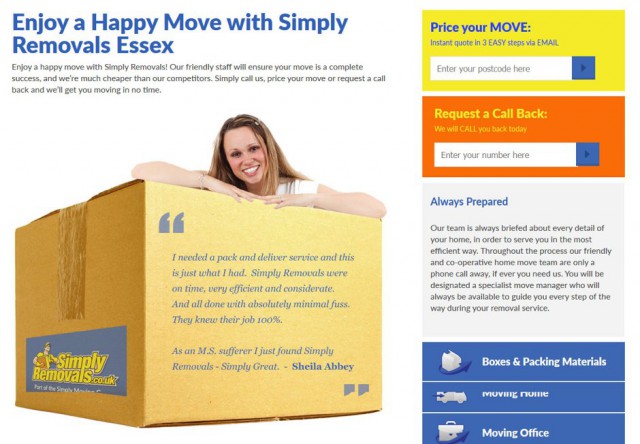5 Examples of Psychology on Landing Pages
As a digital marketing company we spend a lot of time studying conversions rates and testing theories out to see if conversion rates can be improved. One of the areas we’ve had most success with is applying psychological principals to how the landing page is design and the type of content that is added to the page.
The human brain is a wonderful thing and it’s amazing how much power there is in psychology. Online marketing has evolved rapidly over the past few decades and so have the way customers interact with websites. With years of research and surfing the web, customers are now immune to a lot of traditional marketing tactics, but there is one thing that hasn’t changed and that is customer psychology.
Marketers are not psychologists but, in a quest to understand what drives consumers’ decisions, they have turned to psychology to understand what could make an impact on a customer’s decision to make a purchase.
Understanding the psychology behind landing page conversions is an interesting journey and we’ve had some quite significant successes.
Quite simply: marketers who know their audience can use psychology to attract, persuade and retain clients.
This article will hopefully help you understand what influences your visitors’ decisions, and I’ve provided some case studies and what has worked for us. Here at Bamboo Nine.
The Psychology of Pleasure
The term ‘Pleasure Principle’ was coined by Sigmund Freud but it has nothing to do with weird dream interpretations or theories about parental relationships. The principle asserts that people will pursue pleasure and avoid pain. As humans, we tend to make decisions based on what makes us happy. Consumers want something that offers pleasure or satisfaction fast, with very little pain or sacrifice on their part.
This is making employees in the digital marketing industry work even harder to hold a potential customer’s attention.
As humans, we are happy when we are brought to a satisfying and logical conclusion. We like to feel in control; with a clear understanding of the product we are considering buying.
If you cater to your customer’s ego by making them feel special you’ll have a much better chance of gaining their trust. Use the word “you” a lot and focus directly on them in a conversational tone This helps customers feel that your business understands their well-being and the choices they are making.

As an example, we changed the landing page on Simply Removals to reflect happiness We used an image of a happy face and juxtaposed it with the words ‘Have a Happy Move in Essex”. We then let it run for a month and the split test results we received at the end of the month clearly displayed a 3.2% increase in conversions. It was a very simply thing to do and as you can see we didn’t spend a lot of time or money on the design. We just changed the text and added an image.
The Psychology of Pain
Another psychological principle to look at when designing a landing page is the psychology of pain. Our natural reaction is to avoid pain; we don’t touch a hot stove because we know it will burn. Whether mental or physical, we are hard-wired to avoid pain wherever possible. The psychology of pain comes into play with our customer’s behaviour as well. The use of pain in marketing can be a very effective technique. People predominantly make purchases based on an emotional response, therefore offering a solution to their pain can be what’s needed.
The psychology of pain in marketing is utilized by making your customer think about what ‘pains’ them and then drawing individual incentives to alleviate that pain. Fear, uncertainty and doubt are often used legitimately by businesses and organizations to make consumers stop, think, and change their behaviour. Be sure to emphasize the consequences of inaction. Loss aversion is a powerful psychological principle that can motivate people to purchase your product so that they avoid any negative outcomes.

A good example of how fear is used on a landing page we created for Ames Group. The headline ‘Don’t Let Pests Plague Your Life’ is full of negativity and pain. And the image of the horrible fly helps to accentuate the feeling of fear. If someone has a problem with pests and they land on this page it preys on that fear and will help them make the decision to call. This landing page resulted in an increase of 2.8% in their conversions for a month. Again, it was a simple change to make and proved effective to their online marketing campaign.
The Psychology of Curiosity
Curiosity is something humans have evolved to possess, and we all have the potential to feel curious. It is curiosity that drives all the click bait headlines we see on social media, as they stoke up our curiosity. You can make use of this on your landing pages by posing a question or offering a solution but they need to click a call to action to find out the answer.
The Psychology of Urgency
One of the most powerful psychological elements that is often utilised in marketing is that of urgency. Urgency is why hundreds of people gather outside store doors on Black Friday and it is also the reason why internet marketers see such a surge in conversions in the last 24 hours of a product launch. Urgency is one of the most powerful psychological tactics.
In urgent situations, the body releases chemicals that sharpen the mind. No matter what form urgency comes in, it facilitates action. By recognising this reality, if landing page creators and conversion optimizers can create urgent situations, they can also create more action and more conversions.
Utilize Social Proof
People are like sheep, they follow each other. Thanks to social media, social proof has gained steam over the past couple of years. Testimonials on your landing page are a great way to entice customers in and, according to studies, they are more likely to be believed if they are accompanied by a corresponding picture.
Social proof is the concept that people will conform to the actions of others under the assumption that those actions are reflective of the correct behaviour. Social proof is one of the major factors that go into a person’s decision to purchase a product. In fact, studies show that 70% of consumers say they look at product reviews before making a purchase, and product reviews are more trusted than product descriptions from manufacturers.
All our clients here at Bamboo Nine have websites with pages for customer reviews and we’ve seen how beneficial this is to conversion rates.
The knowledge of what drives or triggers a customer’s behaviour is pure gold for your marketing campaign. If you take the time to test and try out different tactics you’ll be surprised at the results you can gain.
To build a successful landing page that draws people in, earns their favour and results in a purchase, can take time. Hopefully by providing some of our insights it will make the process a little easier for you. But I’d love to hear if you have any comments or insights you can add to the discussion, so please feel free to leave me a comment. I’d love to hear your views!
Would you like to receive similar articles by email?





